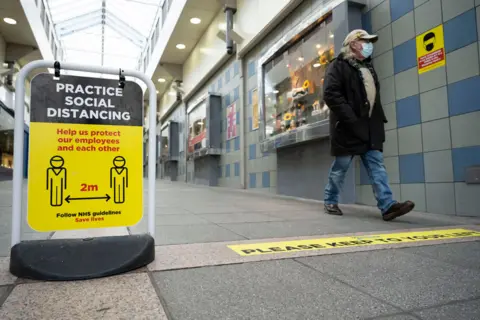Covid-19: Deaths show another weekly fall in Wales
 Getty Images
Getty ImagesThere were 361 deaths involving Covid-19 in Wales in the latest weekly figures from the Office for National Statistics (ONS).
This is 86 fewer than last week - and the second successive fall - but Covid still accounts for 37.1% of all deaths.
It takes the total number of deaths, as measured by the ONS, in the pandemic in Wales to 6,843.
Betsi Cadwaladr - with 73 deaths - experienced its second worst week of the pandemic.
They included 42 deaths in north Wales hospitals and 29 in care homes, in the week ending 29 January.
Nearly two thirds of these were in north-east Wales, which has been the hotpot for Covid in Wales in recent weeks.
There were 13 deaths in hospital involving Flintshire residents and 12 in Wrexham, which also had 12 deaths involving care home residents.

How many deaths have there been elsewhere?
There were also 66 deaths in Cwm Taf Morgannwg, including 23 hospital deaths in Rhondda Cynon Taf (RCT) and 14 in Bridgend.
There were also 27 hospital deaths in Cardiff, while Carmarthenshire had 18 care home deaths and 17 in hospital.
It was still the sixth highest weekly total of deaths involving Covid, although it has fallen back from numbers seen in mid-January.
Up to and registered by 29 January, the total is 6,691 people. When deaths registered over the following few days are counted, the total is 6,843.

RCT, with 821 deaths, has the largest number of Covid-19 deaths occurring in Wales, followed by Cardiff with 753 up to the latest week.
When looking at crude death rates - based on local populations - Wales has three of the highest 10 across England and Wales.
RCT has 340.3 deaths per 100,000 in total so far in the pandemic, which is third highest across England and Wales. Merthyr is fifth with 323.2. Bridgend is also in the highest 10.
There were 93 deaths involving Covid in care homes in Wales.
So far during the pandemic, 6,694 deaths (15.9%) mentioned Covid-19 on the death certificate.
With deaths occurring up to 29 January but counting registrations in the week or so after, the total is 6,843.

What about 'excess deaths'?
So-called excess deaths, which compare all registered deaths with previous years, continue to be above the five-year average.
Looking at the number of deaths we would normally expect to see at this point in the year is seen as a useful measure of how the pandemic is progressing.
In Wales, the number of deaths from all causes fell again from 1,077 to 974, but it was still 172 deaths (21.4%) above the five-year average.
The highest proportion of excess deaths was 98.8% in London.
The number of deaths, as reported daily by Public Health Wales, passed the 5,000 mark on Monday.
But this only records deaths which have a confirmed Covid-19 diagnosis, backed up by a laboratory test, and mostly involve hospital deaths.
ONS takes a little longer to report deaths because it collates details of death registrations, in which doctors mention Covid when it is suspected or confirmed as a cause of death. In around 90% of cases, it is the underlying cause of death.
This also covers deaths in all settings, from hospitals to hospices, care homes and people's homes and is regarded as giving a fuller picture.
The worst days in the pandemic have been during the second wave. Under the Public Health Wales measure, it was 57 deaths on 1 January, when there were 63 registered Covid deaths in total. On 11 January, there were 81 registered deaths involving Covid, according to ONS figures.
